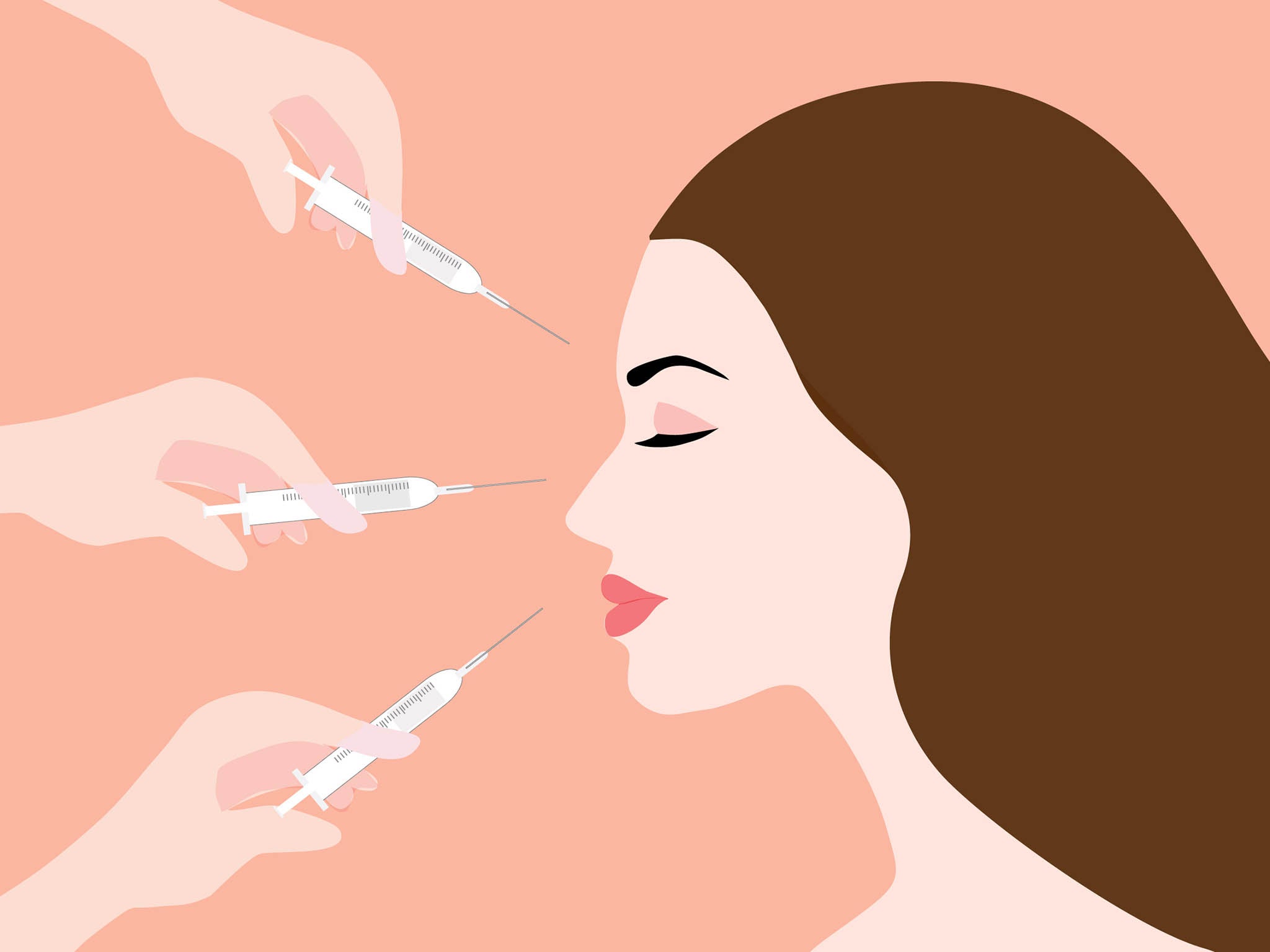‘My dentist injects me, but I trust him’: Inside the scary world of unregulated Botox
Research has shown that just 32 per cent of those administering cosmetic injectables to eager Brits are qualified doctors, writes Olivia Petter. Even stranger is that few on the receiving end seem to care


When Lily*, 29, needs to top up her Botox, she goes to her dentist. “I know that he deals with needles, so it doesn’t bother me,” she shrugs. “Rates of Botox have gone up, so he makes a pretty solid profit from it and does it on the side for extra cash. I have friends who will only do it with people who have a proper qualification. But I trust him; he specialises in Invisalign.”
Lily is not alone. In fact, she is just one of an increasing number of people in the UK receiving cosmetic surgery injections – such as Botox – from professionals who are not qualified doctors. “I used to get Botox from a family friend who was a plastic surgeon,” adds 27-year-old May*. “He’d come over with leftovers of it and just give it to us.”
According to research from University of College London, just 32 per cent of those administering cosmetic injectables are doctors. The study, which looked at 3,000 websites to find out the qualifications, training and experience of those offering said treatments, found that 13 per cent were nurses and 24 per cent were dentists. And of the 1,163 doctors that were identified, less than half (41 per cent) were on the specialist register and just one fifth (19 per cent) were on the GP register. Writing in the Journal of Plastic, Reconstructive & Aesthetic Surgery, the study’s co-author Professor Julie Davies said: “Our findings should be a wake-up call for legislators to implement effective regulation and professional standards to safeguard patients from complications.”
So far, Lily’s Botox has gone without complications. But her dentist could be one of many performing the procedure without adequate qualifications. To professionals, tales of unqualified injectors are alarming, particularly when you consider the risks of Botox. One study from 2021 found that one in six people who’ve had it injected into their face suffer from complications, ranging from bruising and nausea to headaches and “frozen” features. The research concluded that there was a 16 per cent complication rate associated with the procedure, a figure that is undoubtedly at risk of increasing given the explosion in unregulated administrators.
“Botox has become one of the most reputable cosmetic treatments available,” says Shelly Woods, advanced aesthetics practitioner and the founder of Skin Techniques. “But when it’s in the wrong hands, it can be disastrous. It has come a long way since the late 1980s when it was first used by doctors in the US to treat eye muscle disorders in their patients. Fast forward to today and the Botox trend is booming. Scalpels are now giving way to syringes.”
Today, Botox is largely used to relax the muscles in your face to smooth out lines and wrinkles. It’s not permanent and usually lasts between three and four months. In the UK, the cost of Botox can range from £100 to £350 depending on the area of the face that is being injected.
The treatment has soared in popularity in recent years, with a 2022 audit by the British Association of Aesthetic Plastic Surgeons (BAAPs) showing that 6,639 Botox treatments were performed by members, resulting in a 124 per cent increase on the previous year. Today, the value of non-surgical cosmetic treatments like Botox and fillers in the UK is estimated to be around £2.75bn.
I got Botox from a beautician who was advertising her services on Facebook. She sent the ends of my eyebrows right up; I looked mad
“I put this down partly to social media,” says cosmetic doctor Dr Shirin Lakhani, who has noticed a recent rise in the number of people, particularly women under 30, seeking Botox. “Treatments are also fuelled by people taking selfies. Young people need support to help distinguish between social media and reality.”
The remarks follow those made in December 2022 by Dr Michael Prager, known as “the king of Botox”, who claimed that young people had “lost the plot” with regards to their approach to tweakments and are being “overly injected” with Botox and fillers.
Naturally, as more people get Botox, concerns about malpractice increase. Such concerns recently prompted the government to introduce new requirements that make it illegal for tweakments to be administered without a licence, and banned Botox for those under the age of 18 – in 2020, the Department of Health estimated that as many as 41,000 Botox procedures had been carried out on under-18s.
In 2021, MPs also recommended that those given Botox and fillers should require psychological pre-screening before a procedure, warning that the “complete absence” of regulation in non-surgical beauty treatments is dangerous and must end. But why are so many young people getting it in the first place?
“The rise of social media has put a lot of pressure on people to look younger and this has fuelled demand,” explains Dr Lakhani. She also points to “the so-called Love Island vibe,” where people wish to emulate the look of reality TV stars and influencers. “Botox is also relatively affordable, unlike surgical treatments,” she adds. “It does not require you to take time off work as there is no downtime. Its effects are temporary so you can stop treatments whenever you want. The results of surgery, in contrast, are permanent and hard to reverse.”

But one of the biggest reasons why young people are seeking Botox in droves is the belief that doing so will prevent them from getting wrinkles in the future. “That’s why I get it,” says Lily, who has had Botox injections since the age of 25. “A lot of women get Botox when it’s too late and they’ve already got fine lines. Getting it now is just common sense.”
This theory is hotly contested among clinicians, however, who are quick to point out the paucity of research regarding the long-term use of Botox. “I see young women coming to me because they think of Botox as a preventative step,” says Dr Lakhani. “But I don’t advise treatment until at least your mid-thirties, depending on the case. Some people do have more significant lines in their twenties … but it’s also important to educate patients, particularly those in their twenties and thirties, on how to look after their skin, and the importance of SPF to prevent skin ageing.”
Nonetheless, the mythical allure of preventing the ageing process was the thing that led Amy Nickell, 33, to start getting it from the age of 23. “I think I always imagined Botox would airbrush me and smooth my skin,” she says. “Once, I got it from a beautician who was advertising her services on Facebook. She sent the ends of my eyebrows right up; I looked mad and felt super self-conscious until it wore off.”
While Nickell experienced bad side effects, there are far worse ways that Botox can go awry if it’s been administered incorrectly. “On the lower end of the scale, [you] could [experience] mild pain, bruising and swelling,” says Lesley Blair MBE, CEO and chair of the British Association of Beauty Therapy & Cosmetology (BABTAC). “[Then] muscle paralysis, facial asymmetry, excessive brow elevation, blurred vision or drooping eyelids and dysphagia, among others. The most concerning potential complication, though, would be an allergic reaction or anaphylaxis, but thankfully this is the least common.”
It only drives home why it’s so vital to have the procedure performed correctly. And as dubious as visiting the dentist for Botox may sound, it has become a growing offering in the UK, with seven of the nation’s biggest dental chains now offering cosmetic procedures, including Botox, in their clinics.
“Dentists actually have quite extensive medical training [on] the anatomy of the face, so [they’re] potentially one of the safer options,” adds Blair. “As a prescriber, they can also manage serious complications if they arise. More concerning would be someone with no medical training [about the] anatomy and physiology of the face, who cannot manage complications and completed an unregulated short course on injectables.”
“I’d advise everyone to do their research and check for their medical qualifications through government bodies [such as] GMC, NMC [and the] GDC,” says advanced nurse practitioner, Dr Emeline Harley, who says she regularly finds herself correcting other people’s questionable Botox work. “It’s so important to check the experience of [your] practitioner and check for pharmaceutical industry accredited certification of training.”
And while it almost goes without saying, if the treatment on offer seems much cheaper than normal, it’s worth proceeding with caution. “In these cases, the low cost is likely due to the use of inferior or even sub-standard online products, or inexperienced practitioners,” explains Dr Harley. “Medically qualified practitioners have no need to massively undercut the competition – their expertise is always in demand.”
But, adds Blair, even safe administering of Botox should come with warning signs. “A younger and younger clientele is becoming the norm among practitioners,” she says. “It’s a self-perpetuating cycle – once a client has started to have injectables, it’s unlikely they will stop.”
*Different names have been used
Join our commenting forum
Join thought-provoking conversations, follow other Independent readers and see their replies
Comments


Bookmark popover
Removed from bookmarks